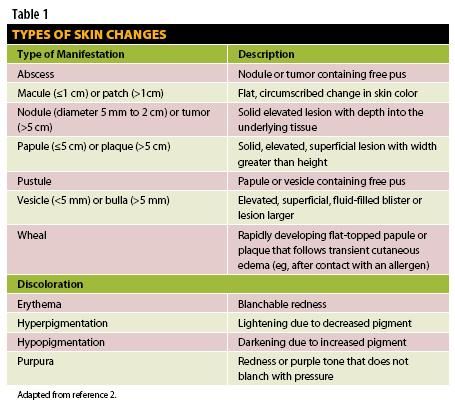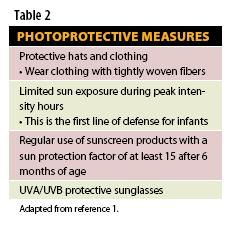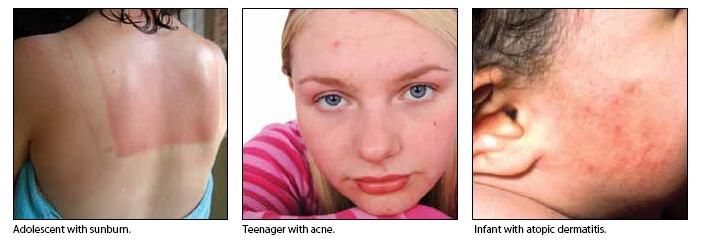Article
Pediatric Skin Conditions: Prevention and Treatment
Author(s):
Key Takeaways
- Pharmacists should educate parents on sun protection to prevent UVR-induced skin damage and discredit tanning myths.
- Impetigo requires referral for prescription treatment, while eczema and contact dermatitis need symptomatic management and potential physician referral.
When patients arrive in the pharmacy with skin issues, here's how the pharmacists can help both the parent and the child.
When Patients Arrive in the Pharmacy with Skin Issues, Here’s How the Pharmacist Can Help Both the Parent and the Child
The skin is more than just a pretty wrapper— it’s a physical barrier to protect our organs and a component of the innate immune response.1 Childhood skin problems, which are common and present in myriad interesting ways (Table 12), can distress patients and their families. Some are rapidly treatable. Others are more obstinate.

Parents may arrive at the pharmacy, “rash-y” child in tow, and ask the pharmacist if an OTC product will help or if they need to see a physician. Pharmacists often struggle with dermatologic symptoms, but a basic understanding of common pediatric skin problems can help them assist patients directly in the pharmacy when possible, and refer others expediently.
Prevention First
Any discussion of pediatric skin conditions should start with sun exposure, because avoiding it is the best—but not the easiest—way to protect children’s skin. Humans need some sun exposure to stimulate vitamin D production. If we overdo it, solar ultraviolet radiation (UVR—a component of sun exposure) can cause sunburn initially, and melanoma and basal cell carcinoma later. UVR is also immunosuppressive, and this may be important as a contributor to skin cancer and infectious diseases.
It’s difficult to predict if or how badly individuals will burn when they spend time outdoors. Geographic location, genetics, underlying medical conditions, and medication use will influence the outcome. The skin remains immature throughout at least the first 2 years of life. Dermatologic UVR-induced changes may begin to accumulate as early as the first summer of life. Sun protection (Table 21) should start at birth and continue throughout life.1
Up to 83% of American children develop sunburn each summer season, and up to 13% burn each summer weekend.3-6 Pharmacists need to discredit the belief that we all look “healthier with a tan” and voice strong objections to tanning beds. Additionally, they should advise parents to apply sunscreen to their children (and themselves) habitually and generously.
If a child is sunburned, OTC acetaminophen, ibuprofen, or naproxen can relieve pain and reduce fever. Recommend light moisturizing gels to keep skin hydrated, but avoid heavy creams because rubbing will irritate the skin. OTC hydrocortisone creams may relieve inflammation and irritation. Suggest using ice packs, cold compresses, or oatmeal baths to ease the itching and discomfort.
Beyond Sunburn

Identifying a specific skin condition starts with gathering historical information. Basic questions include:
- When and how did it start?
- How long has it lasted?
- Has it changed over time?
- Are there any other local or systemic symptoms, such as itching, pain, or fever?
- Did you try any home remedies, and if so, what happened?
The Kiss of Bacteria
Impetigo is a bacterial infection. Colonization with group A beta-hemolytic streptococci or Staphylococcus aureus causes nonbullous impetigo after minor skin trauma. It begins as small vesicles or pustules that rupture and form a honeycolored crust. New lesions follow quickly. Lesions under the diaper area can be complicated with fungal infections or gramnegative bacteria.
Children, usually between ages 2 and 5 years, may develop bullous impetigo. Its flaccid bullae develop from epidermolytic toxin produced by S aureus. Untreated, it can progress to cellulitis, poststreptococcal acute glomerulonephritis, and superinfection of the initial lesion. Referral to a prescriber is important, as topical mupirocin is an effective but prescription cure. Good compliance with mupirocin is essential. Systemic antibiotics (penicillinase-resistant penicillins, erythromycin, cephalosporin, or clindamycin) are effective alternatives.1
A Walk in the Park?
If papules and plaques that scale and cause intense itching are the patient’s primary complaint, suspect eczema. There are numerous forms of eczema, with atopic, contact, seborrheic, stasis, and photocontact being the most common. Eczema can also occur when skin thickens secondary to scratching and rubbing (lichen simplex chronicus), or pursuant to niacin or riboflavin deficiencies. A referral to a physician is needed for a biopsy to definitively diagnose.
Kids get into all kinds of things and frequently develop contact dermatitis. Poison ivy, for example, is an allergic contact dermatitis. Like other forms of allergic contact dermatitis, it is caused by direct skin contact with a substance that the body recognizes as foreign. That rash may come later—a delayed-hypersensitivity immunologic reaction creates inflammation—and patients may be more likely to develop symptoms on thinner skin surfaces.
People often believe incorrectly that poison ivy spreads or is contagious. Poison ivy may look like it is spreading, but actually it erupts at different times on different parts of the body, depending on a number of factors, such as skin thickness and exposure time. Avoiding poison ivy plants is wise, but if exposed, washing all clothing is imperative or rhus oleoresin will further contaminate the skin—the affected individual’s and anyone else’s if they touch the clothing. Treatment is primarily symptomatic, including topical corticosteroids, cold compresses, and calamine lotion. Patients with severe allergic contact dermatitis need tapering doses of oral corticosteroids, and need referral to a prescriber. Nickel and rubber are also common skin allergens, and cause an eczemalike itchy, scaly rash.1,7
Contact dermatitis has no immunologic component and is caused by direct tissue insult. Depending on the irritant type, the exposure duration, and the child’s atopic predisposition, it may present as pruritus, pain, or erythematous papules and vesicles. Later, cracking and fissuring of the affected skin surface may occur. Exposure to water and detergents is a frequent cause. If a precipitant can be identified, patients can avoid it. Here, too, treatment is symptomatic with topical corticosteroid creams, lotions, and ointments.8
Atopic Dermatitis
Approximately 10% to 20% of children, usually in the infant or early childhood years, develop atopic dermatitis. Its incidence is rapidly increasing, and experts attribute this to genetic factors (cutaneous immune dysfunction) and environment.9
Atopic dermatitis results from increased levels of IgE and Th1 and Th2 cell proliferation, which cause an overproduction of cytokines.10 This chronic inflammatory condition adversely affects quality of life because of its symptoms and intense treatment schedule. Symptoms include atopy, pruritus, and eczema, often with allergic rhinitis or asthma. Itching is intense, and children will have erythematous, excoriated, scaling papules, and plaques. These lesions become chronic and thickened from rubbing and scratching.
Referral to a dermatologist is critical. In addition to skin hydration, intermittent topical corticosteroids, and elimination of precipitating irritants, a patient may periodically need systemic corticosteroids for acute crises. Pimecrolimus cream or tacrolimus ointment may help. Phototherapy, gamma interferon, or intravenous immunoglobulin may be used.10 Oral antihistamines may offer symptomatic relief.
The Scourge of Acne
Almost every child will develop acne vulgaris, usually after age 8 or 9 years and continuing into the early twenties. Acne is the work of Propionibacterium acnes, which promotes lipase, protease, and chemotactic factor production. Intrinsic factors contribute to the patient’s immunologic response. Extrinsic factors (including friction, sunlight, chemicals, and certain cosmetics) can aggravate acne.1,11
Acne’s inflammatory papules, pustules, nodules, and cysts and noninflammatory, open (blackheads) and closed (whiteheads) comedones are treated differently. Topical retinoid creams, gels, or solutions are preferred for comedones. Caution patients about photosensitivity and the possibility of an initial worsening of acne. Improvement may take up to 3 months.11
Topical benzoyl peroxide is the first step for inflammatory acne. If improvement is inadequate, refer to a prescriber for topical clindamycin or erythromycin. 11,12
Oral antibiotics (tetracycline, minocycline, doxycycline, erythromycin), or oral isotretinoin may be used/recommended if inflammatory acne is severe. Patients need good counseling when oral agents are used, and particularly when isotretinoin is employed. 11,13
In some adolescent females, starting oral contraceptives containing norgestimate or drospirenone and ethinyl estradiol can improve acne. Low-dose corticosteroids and androgen inhibitors (spironolactone) may also be used.11,13
Drug Reactions
Many children have allergic reactions to drugs. Approximately 2.5% of children who are treated with a drug, and up to 12% of children treated with an antibiotic, will experience a cutaneous drug reaction.14-16 Simple drug eruptions usually “blossom” within a week or 2 of starting medication. Children are usually afebrile. Typically, the eruptions are itchy, erythematous wheals. Sometimes, angioedema is present. Photosensitivity, the result of an interaction of the drug or its metabolites with light energy, is also common.
In serious cases, erythema multiforme, Stevens-Johnson syndrome, and toxic epidermal necrolysis are grave reactions starting as blisters or bullae. For all cases, treatment begins with stopping the offending agent. Mild cases typically resolve within 2 weeks. Antihistamines and topical antipruritics may be helpful.
Pharmacists should refer all children who have drug reactions to a pediatrician. Severe hypersensitivity reactions require emergency treatment. Later, it is prudent to confirm that the cutaneous reaction was an adverse drug reaction, make a note of it on the child’s record, and encourage parents to make note of it also. This avoids exposure later.17
Conclusion
Many childhood skin problems are minor and can be treated with OTC products. Others are more complicated and may need prescription drug products or other treatments. Pharmacists can find pictures of the most common and treatable rashes on the Internet. Sometimes, the best intervention is to refer to a prescribing health care professional. PT

Ms. Wick is a senior clinical research pharmacist at the National Cancer Institute, National Institutes of Health, Bethesda, Maryland. The views expressed are those of the author and not those of any government agency.






